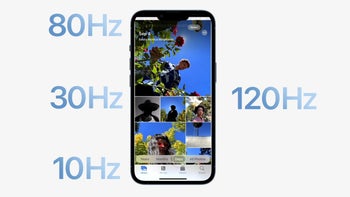Apple's first 120Hz display on an iPhone is all Samsung, down to the refresh range

We heard that Apple will be catching up to Android phones by introducing a high refresh rate ProMotion display exactly a year ago, when it became clear that the 120Hz panels have been postponed for the iPhone 13 series.
A bit strange, given that Apple was first to use the LTPO type of display that allows the adjustable refresh technology on the Apple Watch, then introduce the ProMotion 120Hz panel on the iPad Pro. Something something with yield and costs, analysts suppose.
Lo and behold, the rumors were true, though, and Apple just unveiled ProMotion for its iPhone 13 Pro models. Are there any feature differences with what Android flagships at first, and then midrangers, have been boasting for a while?

Apple iPhone 13 Pro Max high 120Hz refresh rate display specs
At first pass, not really. The "all-new Super Retina XDR display with ProMotion featuring an adaptive refresh rate up to 120Hz, making the touch experience faster and more responsive" does what it says on the tin, and what Samsung's displays have been doing for a while.
Yes, the ProMotion Retina XDR panel on the iPhone 13 Pro/Max is made by Samsung, just like the best such high refresh panel so far, the one on the OnePlus 9 Pro, is also made by Samsung.
While OnePlus put its own twist on the panel with per-unit calibration, and a wider, 1Hz-120Hz adaptive refresh rate, instead of the 10Hz-120Hz that the Galaxy S21 Ultra specs muster, Apple is seemingly content to take the panel from Samsung as is. It does say that it added a continuously adaptive refresh rate, though, so dynamic that it changes each time you touch the screen.
The iPhone 13 Pro/Max 120Hz ProMotion display features
In the press release for the new iPhone 13 Pro models' screen Apple cites 10Hz-120Hz dynamic refresh range, or just what Samsung offers off the shelf. At first brush, this may seem like a lazy approach when you realize that the OnePlus 9 Pro panel rarely, if ever, goes down to 1Hz, or even 10Hz.
Most of the time we tested, it was either at 60Hz or at 120Hz, depending on the content shown, with very brief dips during video playback. Apple, on the other hand, clearly shows the usage scenarios in which its iPhone 13 Pro/Max display controller adjusts the refresh rate, from 10Hz to 120Hz indeed.
Most of the time we tested, it was either at 60Hz or at 120Hz, depending on the content shown, with very brief dips during video playback. Apple, on the other hand, clearly shows the usage scenarios in which its iPhone 13 Pro/Max display controller adjusts the refresh rate, from 10Hz to 120Hz indeed.
Apple's twist here seems to be continuously adjusting the display refresh rate while you touch it. Swipe for the next photo, for instance and the display immediately ramps up to 120Hz to make the transitional animation as smooth looking as possible, then apparently throttles the refresh down to 80Hz/60Hz/30Hz, and, finally, to 10Hz when you are just looking at the photo without doing anything with it.
This helps save on the otherwise trying power draw of high refresh rate displays yet is something all such panels on Android phones already do to one extent or another, plus it remains to be seen if the iPhone 13 Pro dynamic refresh really works like that in practice.

Will the iPhone 14 have 120Hz ProMotion display?
Perhaps one of the reasons for the iPhone 13 missing the 120Hz refresh deadline is that its old school 60Hz LTPS OLED display, and the 5.4" such panel of the 13 mini, are reportedly made made by LG, rather than Samsung. Last year, Apple finally managed to diversify its OLED screen suppliers by tasking LG with producing the iPhone 12 display, and this year it has ordered up to 50 million panels from Samsung's competitor, too.
The problem? Well, LG just doesn't make LTPO displays in a size bigger than those for the Apple Watch yet, Thus, it can't really craft panels that will refresh 120 time per second, and won't kill the battery, especially where the 13 mini is concerned, as its predecessor's battery life is pretty abysmal as it is.
LG, however, "is planning to convert its line to LTPO TFT OLED in the hopes that it will supply them to Apple next year," tip insiders, and this can only mean one thing - Apple may have two suppliers capable of making modern 120Hz LTPO panels in time for the iPhone 14 series where all of the models will sport high refresh rate panels, not just the more expensive Pro versions.
Here's to hoping, but is the 120Hz ProMotion display of an iPhone 13 Pro enough to sway you to buy it instead of the iPhone 13?










Things that are NOT allowed: